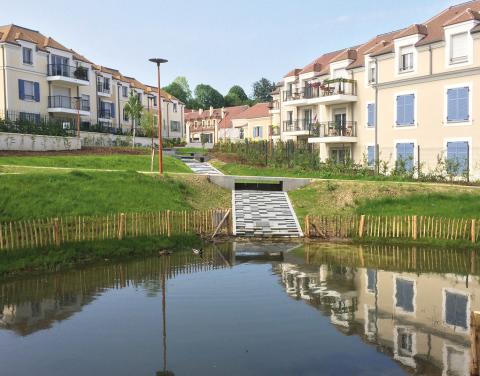General
National Id
France_11
Summary
The city of Fourqueux (4000 inhabitants) has redesigned its urban space to build social housing. A plot of land has been set up at the heart of this area to collect and manage rainwater from the requalified area. Called water garden, the park collects water from 1.7 hectares of permeable and impervious area to allow it to infiltrate through a succession of temporary basins and a permanent one. It thus avoids the direct discharge of this rainwater into the separative network connected to the Seine. The water garden also acts as a natural space in the heart of a residential area, and allows the history of the municipality to be highlighted through cultural activities and the permanent display of old agricultural machinery.
Reviewed by
Fribourg-blanc
Light or indepth?
In-depth
The in-depth description of the case study
Location description
The commune of Fourqueux is located in the Yvelines, and has 4000 inhabitants.
In 2014, the center of the municipality of Fourqueux underwent an urban redevelopment operation, consisting of the creation of 80 housing units and the renovation and restructuring of the municipal social and cultural center. In addition, this work has led to the establishment of separate networks.
The area under requalification covers 1.7 hectares. In the center of this area was a private garden of 3200 m² dating from the 1930s, abandoned and left fallow. It was acquired by the city with the objective of making it a local park. Stormwater management was initially planned through underground networks in the road network, before the construction of the water garden in the park was considered.
The private garden was fallow, with natural biodiversity and no direct pressure. The subsoil of the area consists of very low-permeability green clays, which leads to the presence of several springs on the site.
In 2014, the center of the municipality of Fourqueux underwent an urban redevelopment operation, consisting of the creation of 80 housing units and the renovation and restructuring of the municipal social and cultural center. In addition, this work has led to the establishment of separate networks.
The area under requalification covers 1.7 hectares. In the center of this area was a private garden of 3200 m² dating from the 1930s, abandoned and left fallow. It was acquired by the city with the objective of making it a local park. Stormwater management was initially planned through underground networks in the road network, before the construction of the water garden in the park was considered.
The private garden was fallow, with natural biodiversity and no direct pressure. The subsoil of the area consists of very low-permeability green clays, which leads to the presence of several springs on the site.
NUTS Code
Île de France
RBD code
FRH-La Seine et les cours d'eau côtiers normands
Transboundary
0
NWRM(s) implemented in the case study
Longitude
2.064136
Latitude
48.887901
Photo gallery


The city's strong commitment to an integrated stormwater management solution, and in line with the urban park objective, was a facilitating element during these discussions.